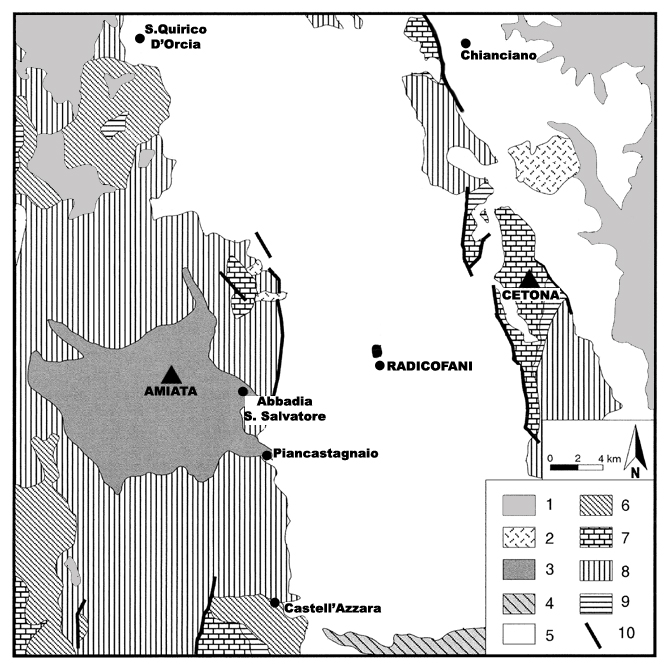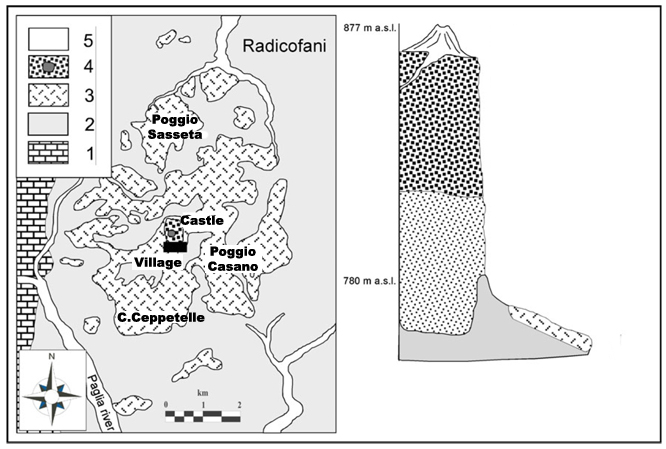Radicofani Volcanic Complex
The small Pleistocene volcanic centre of Radicofani is located in the central portion of the Neogene Radicofani Basin, about 10 km to the east of the much larger and younger Monte Amiata volcano (Fig.1).The Radicofani volcano lies within the central portion of the Radicofani basin, which is filled with Pliocene marine sediments. The Radicofani basin represents the southernmost branch of the Siena-Radicofani graben, one of the most important post-orogenic extensional tectonic features of the Northern Apennine. The graben is presently constituted by the valleys of the Orcia and Paglia rivers, which are separated by the doming of the graben floor at the Radicofani volcano. This doming has been interpreted either as the effect of a shallow level intrusion of a laccolith beneath the Radicofani centre, or as the result of the different tectonic regimes between the Siena and Radicofani basins, the two branches of the Siena-Radicofani graben.
Seismic, gravimetrical and stratigraphical studies showed that the Radicofani Basin is bounded, by both the eastern and western sides, by normal listric faults dipping towards the centre of the basin. It is very likely that one of this faults acted as the pathway for the uprising of Radicofani magmas. Close to the centre of the basin, the Pliocene sediments, constituted by prevailing blue-grey clays with subordinate conglomerates and sandstones, reach a maximum thickness of more than 2500 m.

Fig.1: Geological sketch map showing the position of the Radicofani volcano within the Radicofani Neogene Basin. 1) Continental, fluvial-lacustrine deposits (Quaternary). 2) Travertine (Quaternary). 3) Mt.Amiata volcanics (0.6-0.4 Ma) 4) Vulsini volcanics (0.6-0.1 Ma) 5) Terrigenous, marine and continental deposits (Miocene sup.-Pliocene). 6) "Macigno" Turbiditic sandstone (Oligocene). 7) Cherty-limestone, radiolarites, marl, limestone and dolomite (Trias. Sup-Cretaceous inf). 8) Ligurian units (ophiolites). 9) Sub-Ligurian units (ophiolites). 10) Main normal faults. Modified after D’Orazio (2003

Fig.2: Geological sketch map of the Radicofani monogenetic volcano. 1) Shale and sandstones with interbedded ophiolitic lenses; 2) Pliocene marine shales with minor lenses of sands; 3) Isolated blocks of dismembered lava flows and blocky lava flows (Poggio Sasseta, Poggio Casano; Case Ceppetelle); 4) volcanic neck with a remnant of a scoria-cinder cone on top; 5) Quaternary alluvial deposits. On the right hand side is the cross section through the neck, not to scale. From Conticelli (2011).
Radicofani is a small volcano formed by ca. 90 m-high well-preserved volcanic neck and by several lava flows (Fig.2). The lava flows are scattered around the neck and lie on top of the Pliocene marine sediments. The original volcanic edifice, possibly made up by a cinder cone, has been completely eroded, and only a thin layer of red scoriae is preserved on the edge of the top of the neck, just west of the castle.
The top of the neck is made up of red vesicular lava that becomes dense and grey to dark grey downward. Columnar jointing is present in the middle and lower portions of the neck in grey and dark grey aphyric to subaphyric lavas. Oxidised septa dividing the different portions of the neck can also be observed. Volcanic debris of scattered isolated lava blocks, of decimetre to decametre in size, are found all around the neck (Fig.2) for several kilometres. Small lava tongues in their original position are present around the neck at Poggio Sasseta, Case Ceppetelle and Poggio Casano (Fig.2).
Rodolico (1935) divided the Radicofani volcano into three different portions: i) the bottom of the neck, ii) the top of the neck and iii) the lava flows. A few radiometric ages are available for these different portions. A sample from the lava flow of Poggio Sasseta (northbound flow) yielded a 40Ar/39Ar age of 1.303+/-0.005 Ma. The lava from the top of the neck yielded K-Ar ages of 1.315+/-0.033Ma and 1.337+/-0.05 Ma. The samples from the bottom of the neck yielded K-Ar ages of 1.08+/-0.05 Ma and 1.22+/-0.06 Ma.
It is worth noting that the volcanic nature of the Radicofani rocks was recognised as far back as 1722, when the botanist, abbot Pier Antonio Micheli identified the black and red scoriae he found at Radicofani as the product of an extinct volcano. The discovery of Pier Antonio Micheli has to be recrodered as one of the first recognition of volcanic formation in an area not volcanically active.
The macroscopic features of the rocks that constitute the neck are variable going from its base towards the flat top (during medieval times, the top of the neck was levelled to build a stronghold). At its base, the neck is made of a homogeneous and massive dark-grey rock. It crops out far 50-60 m by thickness and can be easily recognised for its irregular columnar jointing. Towards the top of the neck, lithologic types differing by colour, vesiculation, flow structures and weathering can be found.
Petrography
In spite of its small size, the Radicofani volcanic rocks have significant compositional variations linked to the different petrographic facies recognized along the neck and within the lava flows.According to the Total Alkali Silica diagram the samples range from basaltic andesite to shoshonite. In the K2O vs. silica diagram the samples straddle the boundary between shoshonite and high-K calc-alkaline rocks. Some of the Radicofani rocks are ultrapotassic.
The high-K basaltic andesites are porphyritic to glomeroporphyritic rocks with a phenocryst assemblage consisting of olivine + plagioc1ase + c1inopyroxene. The intersertal groundmass is composed of plagioclase, clinopyroxene, ilmenite, alkali feldspar, interstitial glass, olivine and scarce brown mica flakes. These rocks can be found only in the lower and intermediate levels of the neck. Olivine is the most abundant phenocryst phase (8-10 vol.%) and frequently hosts small octahedra of Cr-rich spinel. It rounded shape and it is partially replaced, along the rims and the internaI microfractures, by bowlingitic products and/or iddingsite.
Shoshonites (both potassic and ultrapotassic) were found in the upper levels of the neck and constitute the lavas of Poggio Sasseta. They are vesiculated, porphyritic rocks with an intersertal to intergranular groundmass. With respect to the high-K basaltic andesites, the shoshonites are characterised by a decrease of the plagioclase/alkali feldspar ratio and a decrease of the plagioclase phenocrysts content. Concurrently, the content of brown mica in the groundmass increases. Olivine is the most abundant phase of the phenocryst assemblage (8-12 vol. %). Olivine phenocrysts can appear c1ear and very fresh, crowded with Fe-Ti oxides or extensively replaced by iddingsite.
Ultrapotassic latites were found exclusively as blocks scattered around the hills surrounding the neck. They are characterised by very low abundances of plagioclase that appears only as rare microlites in the groundmass. Two main textural type are found:
The first (Poggio Casano lavas) is represented by porphyritic lavas characterised by the abundance of olivine phenocrysts (10 vol.%) often partially replaced by iddingsite and bearing small inclusion of Cr-spinel. The groundmass is dominated by alkali-feldspar joined by clinopyroxene, brown mica, ilmenite, apatite and moderate quantity of olivine, plagioclase, brown amphibole and interstitial glass.
The second (Case Ceppetelle locality) is characterised by an holocrystalline poikilitic texture with plagues of abundant, clear, and colourless alkali feldspar that include crystals of other mineral phases (olivine, pyroxenes, mica amphiboles, Fe-Ti-oxides and rare plagioclase).
The volcanic rocks from Radicofani commonly contain millimetre-sized quartz xenocrysts or quartz aggregates that, occasionally, can reach up to several centimetres in size. Quartz xenocrysts are rounded and mantled by a well developed reaction rim constituted of acicular green clinopyroxene crystals. Less frequently, cordierite xenocrysts and microxenoliths made up of andalusite+sillimanite+green spinel+anorthite were also found.
Petrogenesis
Most of the rocks of the Radicofani volcano are ultrapotassic shoshonites associated to younger basaltic andesites, found at the bottom of the neck. K2O contents are positively correlated with trace element and isotopic variations. Shoshonitic and high-K calc-alkaline rocks of the Radicofani volcano are significantly different from shoshonites occurring in association with leucite-bearing ultrapotassic rocks in the southernmost portion of the Roman Magmatic Province. The Radicofani rocks are characterised by high, but variable, levels of incompatible trace elements with a subduction-related signature, with troughs at Ba, Ta, Nb, and Ti, and peaks at Cs, K, Th, U, and Pb. Ultrapotassic shoshonites show the highest incompatible trace element contents coupled with the highest 87Sr/86Sr and the lowest 143Nd/144Nd.On the basis of geochemical and isotopic signatures it is argued that magmas were generated in a modified lithospheric peridotitic source containing metasomatic veins generated by K-rich melts from recycled sediments within the mantle via subduction. A further metasomatic event generated by slab-derived fluids pervasively enriched the peridotitic source.
Partial melting, triggered by rising of the isotherms after the orogenic front migrated eastward in the Italian Peninsula, firstly consumed the low solidus domains (veins), generating leucite-free ultrapotassic magmas (lamproite), successively began to involve also the surrounding pervasively metasomatised peridotite, resulting in the production of the intermediate products (shoshonites, high K-calc-alkaline) and eventually giving raise to the high K-calc-alkaline magmas.
.jpg)
Panoramic view of the Radicofani monogenetic volcano
.jpg)
Panoramic view of the Radicofani monogenetic volcano
1.jpg)
Vesicular scoriae. Radicofani neck. From Museo di Storia Naturale dell'Accademia dei Fisiocritici (Siena).
.jpg)
Vesicular scoriae. Radicofani neck. From Museo di Storia Naturale dell'Accademia dei Fisiocritici (Siena).
.jpg)
Subaphyric shoshonite with metasedimentary xenolith (white). Radicofani volcano. From Museo di Storia Naturale dell'Accademia dei Fisiocritici (Siena).
qtz.jpg)
Subaphyric shoshonite with cm-size quartz xenocryst. Radicofani volcano. From Museo di Storia Naturale dell'Accademia dei Fisiocritici (Siena).
Bibliography
• D’Orazio M (2003) The Radicofani volcano. In: Poli G, Perugini D, Rocchi S, and Dini A (eds), Miocene to Recent Plutonism and Volcanism in the Tuscan Magmatic Province, Period Mineral 72:183-193.
• Conticelli, S., Avanzinelli, R., Marchionni, S., Tommasini, S., & Melluso, L. (2011). Sr-Nd-Pb isotopes from the Radicofani Volcano, Central Italy: constraints on heterogeneities in a veined mantle responsible for the shift from ultrapotassic shoshonite to basaltic andesite magmas in a post-collisional setting. Mineralogy and Petrology, 103(1-4), 123-148.81.



(6).jpg)
(7).jpg)
(8).jpg)
(9).jpg)
(10).jpg)
(1).jpg)
(2).jpg)
(3).jpg)
(4).jpg)
(5).jpg)
(11).jpg)
(12).jpg)
(13).jpg)
(14).jpg)
(15).jpg)
(17).jpg)
(18).jpg)
(16).jpg)
(1).jpg)
(2).jpg)
(3).jpg)
(4).jpg)
(5).jpg)
(6).jpg)
(7).jpg)
(8).jpg)
(9).jpg)
(10).jpg)
(11).jpg)
(12).jpg)
(13).jpg)
(14).jpg)
(16).jpg)
(17).jpg)
(15).jpg)
(19).jpg)
(20).jpg)
(21).jpg)
(25).jpg)
(2).jpg)
(3).jpg)
(5).jpg)
(6).jpg)
(7).jpg)
(8).jpg)
(9).jpg)
(4).jpg)
(1).jpg)
(7).jpg)
(2).jpg)
(1).jpg)
(3).jpg)
(4).jpg)
(5).jpg)